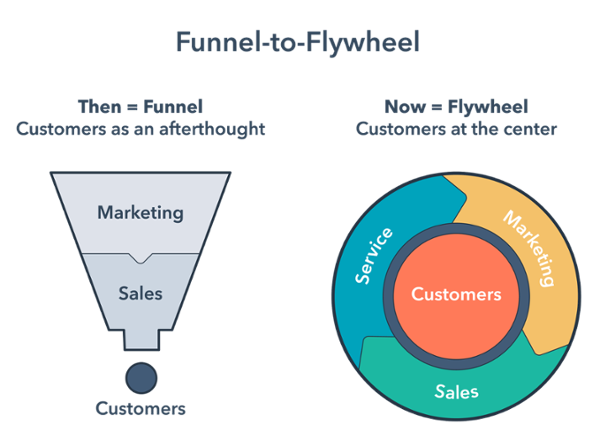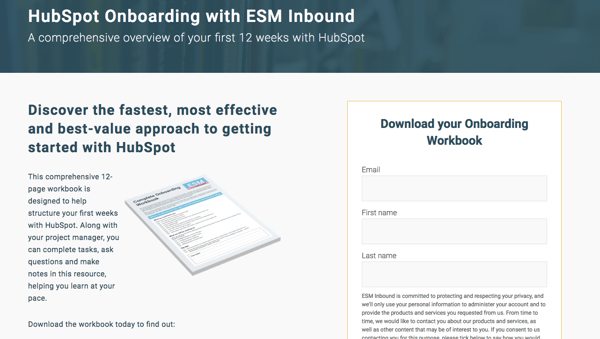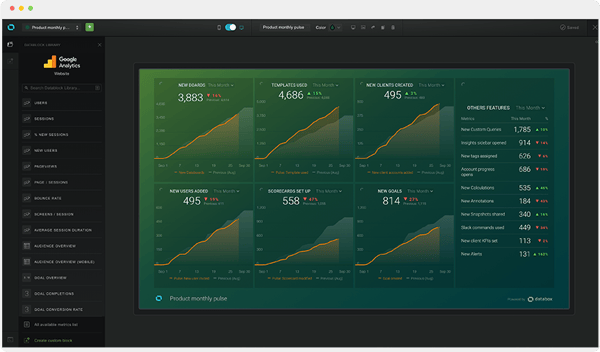Trying new marketing methods, making trials and errors, and discovering what works and what doesn’t for your customer, is something we all know we should be doing more of.
But with the sheer volume of work most of us faces, with stretched teams and tight deadlines, it’s easy to fall back into patterns of ‘what we’ve always done’.
Inbound marketing, if you haven't tried it, might seem a daunting prospect to begin with, if you’ve been conducting more traditional forms of marketing such as TV and radio adverts, print advertising, billboards, and cold calls for a long time. Or it could be that you’ve already started blogging and emailing in a more inbound way but don’t know how to build a whole campaign around this content. Prism Global explains that, while this is a good start to an inbound campaign, it isn't the full story:
"While it may seem like a lot to take on, it becomes much more manageable and sustainable if you think of each piece of content as its own integrated inbound marketing campaign. Each piece needs to flow together in order to help your content gain the most traction online. If you only focus on one or two of these items, the reach of your campaign will be far less than it would be as an integrated inbound campaign."
In this article, all will become clear: we’ll help you understand the principles of inbound, walk you through the steps of your first campaign and help you decide if inbound could be the right solution for your business.
So what is an inbound marketing campaign?
The definition of an inbound marketing campaign is a content-driven activity with the goal of attracting new leads to your business. Inbound campaigns usually focus on answering the questions a buyer persona asks before buying a product or service. The content may or may not be gated but will be supported by lead generation resources such as forms, live chat/bots or meeting schedulers.
We recently went into lots of detail exploring what inbound marketing is, so if you don’t already know, that’s a good place to start. So – once you understand the principles – what does a full inbound campaign look like? HubSpot helpfully identifies what it is in under 100 words:
“Inbound marketing campaigns are concentrated efforts that align all of your marketing channels around a single message and goal. It starts with a marketing offer – something valuable and relevant for your audience that you promote through your marketing channels. Then, you nurture the leads from that offer and move them along your marketing funnel so they can become your customers. And don't forget to measure and analyse your campaign. And that’s how you run an inbound marketing campaign!”
More recently, HubSpot has introduced the idea of the inbound ‘flywheel’, instead of ‘funnel’. Instead of merely squeezing your prospects through one end of the purchasing journey to the other, as though they are on a conveyor belt in a factory, you need to treat the sales process as a cyclic, repeatable system. Inbound isn’t about churning out customers, getting their money then forgetting about them, it's a process that continues to nurture them.

An inbound marketing campaign is structured so that one action leads onto another, and at the end you start all over again, never forgetting your main goal of keeping customers at the heart of the process through delivering outstanding service, sales and educational content. The flywheel is explained in more detail in this handy video from HubSpot below:
We’re sure you already know, but in case you don’t – let’s look at what we actually mean by “campaign”. Klood helpfully sums it up as:
“A campaign is defined as a marketing push centred around one single goal or message. They are often time-related, focused on a particular event, or around a particular piece of content.”
This is exactly what you’ll be doing when creating your inbound campaign: building an awesome piece of content (or ‘lead magnet’) that your customers seriously want to get their hands on. Then you’ll build awareness around it, guiding your users to find it through social media, blogging and emailing, encouraging them to exchange their details for it, then you’ll nurture them with follow-up content, moving them onto the next stage of the flywheel, until they become customers.
How is an inbound campaign structured?
Unlike Yoda, we think it's okay to try: if you’re keen to give your first inbound campaign a go but don’t know where to start, we’ve mapped out five steps to help you structure and plan, including the important elements of any inbound marketing campaign.
Remember, these steps will be personal to your business, and depending on your buyer persona research and business goals, each marketer will make different decisions about the content to create: but the principles remain the same:
Step 1: You create an amazing piece of content that your buyer persona will love. This content is aligned to your business goals and is in a format that you know (from your research into their pain points and watering holes) your audience will enjoy – an ebook, a guide, a checklist, video or something else remarkable.
Step 2: You will position this piece of content behind a gated landing page, meaning that to access it, your audience first has to enter their contact details into a lead-capture form. This is a two-way benefit: your prospect downloads a super-helpful, expert resource from you, while you receive their details for your database in return – they are now a lead.
 Here is an example of one of our landing pages with a lead-capture form to the right: after filling this in, the prospect receives a fabulous content offer (in this case, a workbook).
Here is an example of one of our landing pages with a lead-capture form to the right: after filling this in, the prospect receives a fabulous content offer (in this case, a workbook).
Step 3: Once downloaded, your prospect will be redirected to a ‘thank you’ page where they can then access their download. Shortly after, they will receive a follow-up email to thank them again and which will offer another useful resource. This option will move them through the flywheel, guiding them further into the purchasing cycle and encouraging them to become a customer.
Step 4: You will promote this piece of content across all channels that you know will reach your buyer persona: this may comprise of social media, emails, blog posts and paid search. As Digital 22 explains:
"...look at both ends of the spectrum: fix what's broken, and double down on what's working really well. For example, this can include analysing what's converting well, such as Landing Pages and blogs. If they're converting really well (over 30 percent, say)... [you] might even decide to pay to share it to get even more eyes on it to improve the conversion numbers further. (Yes, inbound marketing can use PPC!)"
Step 5: As Digital 22 mention above, you have to monitor the results. Use a data dashboard – HubSpot, Databox or a similar platform – to see what kind of engagement your new campaign is getting. This is vital to your ongoing campaign: it isn't over when the campaign goes live, it's only just beginning.
If your first piece of content is an awareness-stage piece, you now need to repeat the process all over again, but this time for a consideration-stage resource. This way, you will help your prospects move to the next stage of their buying journey until they become your customer. This can all be informed by the precious insights you observe in user behaviour through your analytics system.
 Databox is just one great tool you can use to track analytics like landing-page visits, form submissions, email open rate, and lead magnet downloads – you can pick and choose the analytics you add to your dashboard, making it bespoke to your business.
Databox is just one great tool you can use to track analytics like landing-page visits, form submissions, email open rate, and lead magnet downloads – you can pick and choose the analytics you add to your dashboard, making it bespoke to your business.
Top tip: There is nothing pushy, aggressive or demanding about an inbound campaign: the focus is on educating, encouraging the prospect to come to you through strong, well-written and delivered content. By the time they speak to your sales team, they will feel in control, not as though they’ve been coerced into a purchase.
Who can use inbound marketing campaigns?
There is no one industry, business size or product that is best-suited to inbound: the beauty of this marketing method is that it can suit anyone – from homewares to HR services, banking to bakeries. Inbound marketing campaigns can be used to increase brand awareness; increase sales; attract new customers; launch a product and more.
How to start an inbound marketing campaign
If you’re still not sure though, here are some questions to ask yourself to help you judge how ready you could be for an inbound marketing campaign:
1. Do you already have some great content? This means content that is educational, helps your prospects make decisions and empowers them to choose the brand, product or service that is right for them (not just pushing your own business). Do you have content that offers solutions?
Top tip: If you’re nodding, then could you repurpose your existing content into something even more valuable for a prospect – could you turn a blog post into a video, an email into a handy checklist or a white paper into an infographic poster? There are plenty of options beyond ebooks, so get creative!
If you don’t already have content like this – perhaps you’re used to only pushing your own product or service – could you create something? An ebook, guide or checklist are great places to start.
2. Do you genuinely want to help your prospects? Is it important to you that they find the right product or solution for them, even if it isn’t yours? Do you love seeing customers satisfied? Are you solutions-minded, keen to jump in and help wherever possible?
3. Do you have a great marketing team? Can they create the content offer, landing pages, blog posts and emails to support the offer, informed by insights learnt from the sales team? Does the team understand the principles of inbound marketing, or can you lead a short training session to help them understand the change in approach?
If you mostly answered “yes” to the above, then you’re ready to start! And even if you didn't, with a few tweaks, you might be ready to give an inbound marketing campaign a go very soon.
What’s the worst that can happen? You try a full inbound campaign and get no leads – if this is the case (and we seriously doubt it) then you can go back to your previous methods, or try again. Don't forget to do your research on the best Inbound Marketing Tools out there to help make your life easier when it comes to generating leads and nurturing prospects!
The world is changing, and the sales landscape is changing even faster – what people now expect from their purchase experience is a brand who understands them, doesn’t push them into decisions, and has their best interests at heart. If you aren’t these things, then customers will simply go elsewhere to someone who is.
Don’t miss out on the opportunity to nurture and gain the trust of your customers – try an inbound campaign and see the exciting places it could lead you.
Still unsure about starting an inbound marketing campaign? Check out our examples of successful inbound campaigns here.
.png)
Lucy Seymour
Stay Updated with Our Latest Insights
Get expert HubSpot tips and integration strategies delivered to your inbox.



